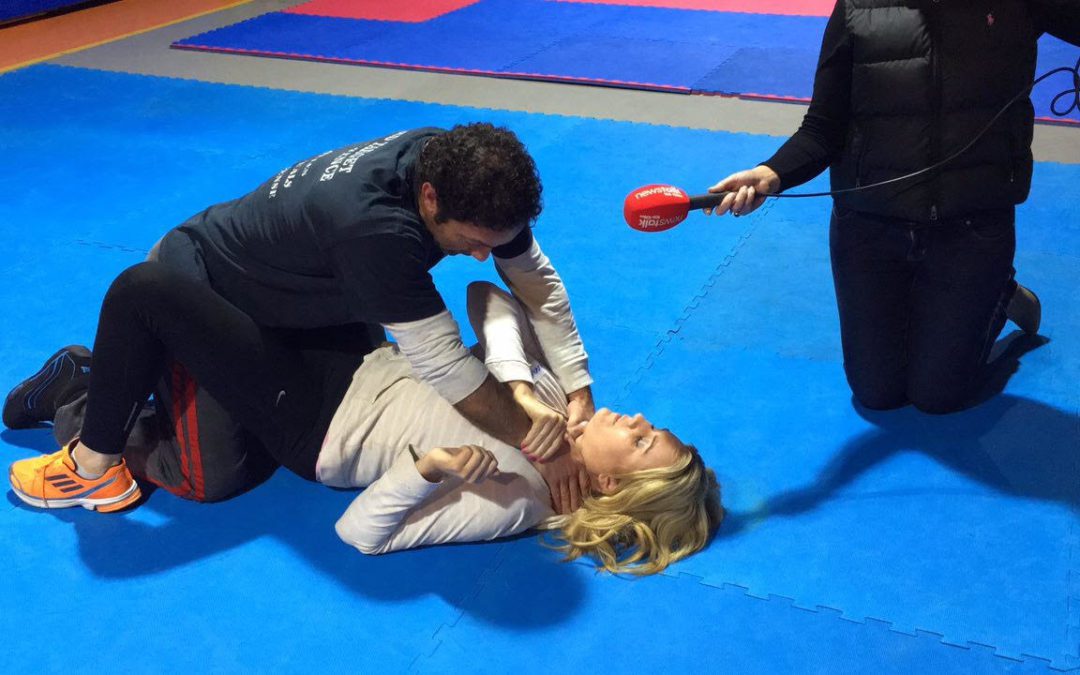Link to full interview at the end of article.
Self-defence tips you shouldn’t leave the house without. First of all, the “keys between the fingers” approach is a bad idea…
As the chief instructor at Hard Target Self-Defence Systems in Donabate, Aidan Carroll is well-versed in the best methods to get you out of sticky street situations as unscathed as possible. With a number of horrific attacks in the capital making headlines recently, Carroll joined The Pat Kenny Show this week to impart some key self-defence pearls of wisdom. Naturally, what you really want is to avoid getting into a volatile one-on-one situation to begin with, and minimise the risks of escalation if you are confronted. For Carroll, that means taking a few figurative steps back before he even looks at the actual physical defence.
Be aware of your surroundings “So there’s going to be lots of precursors,” he explains. “Lots of signals being sent before the actual attack. It’s very important that we’re able to spot the anomalies, recognise them.” To illustrate his point that improving your physical abilities is only one part of self-defence, he offered the following anecdote: “There was a young lady [who did] one of our courses the other day. At the end of the course, we often look for some verbal feedback, and written feedback as well. “And I said to her, what did you get from the course? Did you find it beneficial, what part did you find most difficult?”
“She pondered for a moment and she said: ‘there’s a shortcut at the back of my house and I was always a little bit anxious, a little bit apprehensive and I never wanted to take it. With the training now and the skills I’d have, I think I’d take the shortcut.’ “I thought, this girl hasn’t been listening. She was really focusing on the physical.” Carroll suggest having a gameplan before you even leave the house. Knowning exactly how you are getting to and from a venue or even having a regular taxi driver who can drop you off and pick you up at specific times will reduce the chances of getting confronted on the street. “Structure”, Carroll says, is key. Don’t overdo it with the drink To tap into that greater awareness, you need to have your wits about you. That means taking it easy on what Carroll calls “the old foe” – alcohol. Carroll advises knowing your limitations when it comes to inebriation, and “preferably” eliminating alcohol consumption if you’re likely to be in risky environs.
“My students will be sick of hearing me complain about alcohol consumption,” he says. “It’s a real problem. It lowers your inhibitions, your situational awareness, and your cognition. And that in turn then affects your body language.” “We know that the ‘bad guys’ select their victims based on body language,” Carroll adds, pointing to a quote from infamous serial killer Ted Bundy in which he admitted to selecting his victims based on the tilt of her head. Don’t be a hero While you might feel like you should really intervene if other people look to be in danger, it’s not wise to wade instinctively into altercations. You can offer aid if you see someone in trouble, but in ways that ensure you stay safe: “It’s not recommended, because I would say with the vast majority of people who have come to us who have been assaulted or been in altercations, alcohol has been involved. “When you have the ego being fed by the alcohol and two egos are clashing? It’s a bit foolhardy to rush in there. Of course we can help, but we don’t need to rush in flexing our muscles. Call for backup, get some assistance.” Control the situation and space Distance management is important if you can’t immediately escape a potential attacker. “The first thing we need to do is monitor the space,” Carroll says. “Maintain the space between us and the bad guy, if you will.”
“It’s simply done [by] just extending your hands out in front of you. Not in an aggressive way, we’re not making a fist as such. I’m showing you my palms. “This is monitoring the space. It’s basically saying in any language ‘stay back’. “So if I can maintain that space and manage the distance, the chances of you getting a hold of me or swinging a punch at my head? I’m safer. “It’s either being all the way in or all the way out. I want to be all the way out, of course.” How to hit hard If you find yourself all in, you want to take the initiative. “The first thing I always say is ‘on your toes and get out of there,'” Carroll continues. “If you can’t, if that’s not an option, if there’s no thoroughfare to escape down, you must close the distance.” At this point, the flinch response will kick in and your hands will move to protect your head as you move forward. Then, the strike: “The base of your hand is what we always tell people to use if they have to strike. The heel of your hand. “That’s going to create a lot of brain shake in the bad guy – you’re going to get a good impact from that.”
Where should you be aiming for? “Anywhere we call ‘the Vital L’, which is really along the jawline, along the neck line, anywhere really below the eyeline. It only takes about four pounds of pressure to shake the brain. “That’s preceded by some brain-engaging dialogue… ‘look, I really don’t want any trouble’. You’re engaging the attacker’s brain for a moment… And then immediately pre-empting from that. “You’ve exhausted your other avenues and you realise the attack is imminent: I must get to him before he gets to me. And legally we can do that.” Drop the victim mentality “We want to be on the offensive,” Carroll explains. “I often do a drill where I ask my student’s permission and I put my hands on their throat. I say ‘what do you think we could do from here?’ “Immediately they think of themselves as a victim. So I say ‘from here I could apply an elbow, I could apply a hand strike.’ But they don’t see it from the attacker’s point of view; they always see it from the victim’s side. “If I maintain in that space, I always want to have my hands above yours. I never want my hands beside me, behind my back or in my pockets. I always want to have my hands above the bad guys. “The more distance you give the bad guy, the more opportunity he has to hit me. Or maybe if there’s a weapon involved, more opportunities to use the weapon.”
Leave your keys in your pocket You might have instinctively grasped your keys when you’re on a lonely street and feeling on edge before, guessing you could do more damage with a jagged piece of metal jutting out of your balled-up fist. But you could be doing yourself more harm than good, Carroll argues: “It’s a common one, this thing gets asked a lot. I wouldn’t recommend it. “If you’re holding your keys in a fist-like way – using it like a striking implement, if you will – I wouldn’t do that.”
Aside from the fact your means of getting into your car or house may end up in nefarious hands, the keys could cause the wrong kind of injury: “It’s not going to stay ‘stable’, if you like, it’s going to kick back into your hand.” Always be looking for an exit “Get in and get out as soon as you can,” Carroll says. “You don’t want to be standing trading punches… “Everything we say here today is common sense but it’s not common practice. It’s not to be hypervigilant or be like a coiled spring. It’s small little measures.”
Listen to the full interview http://www.newstalk.com/podcasts/The_Pat_Kenny_Show/Highlights_from_The_Pat_Kenny_Show/191476/Self_defence_tips
Newstalk, The Pat Kenny Show, May 11th, 2017

